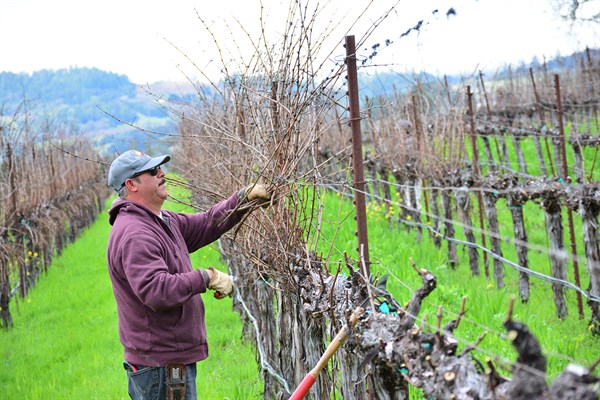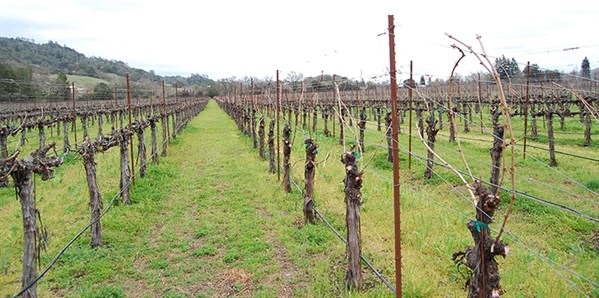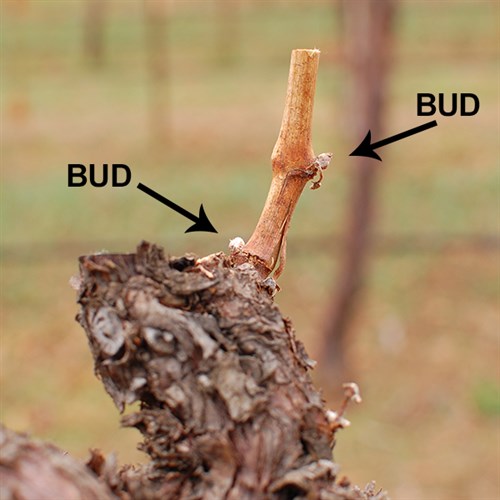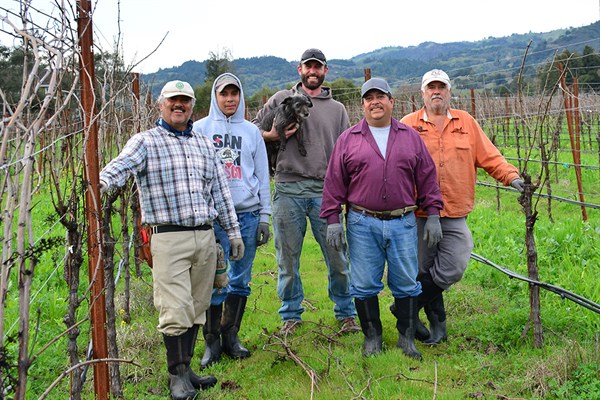Vineyard Pruning
- February 1, 2018
Pruning is vital. First, it aims to restrict the vine to a certain space. Otherwise it will sprawl as any vine would. Second, it focuses the fruit into a narrow zone. This helps encourage uniformity in the grapes through consistent exposure to the elements. We call this the “fruit zone”. Third, pruning controls the amount of fruit that can grow. Grapevines’ tendency is to focus on growth of vegetation not fruit production – territory over reproduction. It’s up to us to restrict that growth but encourage just the right amount of vigor to ripen the crop.
When pruning, the crew cuts off 90 – 95% of the growth from the previous vintage in order to focus the vine’s production and structure. Each pruner looks at the vine and its growth from the previous year to determine what he will cut.
 (Martín has pruned the vines in the foreground and continues his way down the row.)
(Martín has pruned the vines in the foreground and continues his way down the row.)
When faced with the challenge of selecting where to cut (as often there are multiple options), the crew considers:
- How close is it to the permanent structure of the vine? (Goal: sprawl containment)
- What direction will it grow and will it interfere with its neighbors? (Goal: even spacing)
- What is the vigor of each candidate? (Goal: vine balance)
Any of these factors can outweigh the other. That is why we are lucky to have the crew that we do. Many of them have walked these rows and tended to the vines for over two decades.
We have two styles of pruning – cane and cordon. On our ranch, a cordon pruned vine has two arms (cordons) stretching out from the main trunk and many short sections of one year old wood, called spurs. A cane pruned vine has a few long sections of one year old wood emanating from the trunk, called canes. Why one year old wood? Because new, crop-producing, growth will only come from one year old wood.
 (Cordon pruned vines are on the left and cane pruned vines are on the right.)
(Cordon pruned vines are on the left and cane pruned vines are on the right.)
The cuttings are neatly organized into every other row. Then with a flail mower, we shred them into bits. This allows our machinery to pass without strewing them out all over the place and speeds up their deterioration so the trapped nutrients can be incorporated back into the soil.
Beginning this year, we did something new. We took samples of one year old wood and sent them to a lab where they dissected individual buds and counted the “primordial inflorescences”. These are the structures in a dormant bud that will become bunches of grapes. This allows us to estimate the potential crop for the coming year and make more informed pruning decisions tailoring the size of the harvest to our needs. We can’t be terribly precise because potential crop does not equal actual crop. Many factors will influence how much of that potential is realized from weather to pest and disease.  Pruning is a beginning and an end – the end of the 2017 vintage and beginning of 2018. It’s the biggest job of the year, so it’s always a relief to finish.
Pruning is a beginning and an end – the end of the 2017 vintage and beginning of 2018. It’s the biggest job of the year, so it’s always a relief to finish.
 (From left to right: Gerardo, Javier, me holding Satanas, Antonio and Jose Luis)
(From left to right: Gerardo, Javier, me holding Satanas, Antonio and Jose Luis)
Over the past few years, we’ve introduced you to our team members and I was shocked at how many of the vineyard crew said pruning is their favorite job! It’s a lot of hard work during a time of year when the vineyard is most inhospitable - rain, cold temperatures, dark mornings and evenings. No bother for our crew. They are seemingly unbothered by the hardship. Each morning we meet up before sunrise, sharpening stones being put to work on the blades of their shears as we discuss the plan for the day. Taking advantage of a relatively dry winter, we are roughly 50% finished for this year. When the last vine is pruned, we will shift our focus to the vineyard floor and go to work on managing the vegetation competing with our vines while we wait for the vineyard to wake up again.



